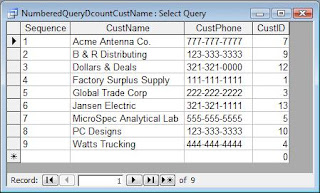So far in this series on Domain Functions, I've discussed the general syntax (Domain Functions Demystified) and problems involved in building criteria expressions (Domain Functions Demystified: Criteria Expressions). Unfortunately, many of the examples I've given are relatively trivial. So for my next few blog posts, I thought I'd give what I consider truly useful applications of domain functions.
Other Examples:
- Simulate AutoNumber with DMax
- Running Sum with DSum
- Difference Between with DMax
- Rolling Average with DAvg and DCount
- Begin Date and End Date from Effective Date
One interesting problem is how to create a numbered sequence in a query, that is, have each record numbered sequentially.
This is fairly easy to accomplish in an Access report. All you need to do in a report is add an unbound text box. In the control source, put =1 and set the Running Sum property to Over All.
But suppose you don't want to do it in a report. Suppose you want to do it directly in a query. There are two different ways to accomplish this. The first uses the Domain Aggregated function DCount and the second uses a Correlated Subquery. Since this series is devoted to domain functions, I'm going to concentrate on that.
Both of these methods require a unique column in the table to create the sequence on. This could be the Primary Key field or any field that has a Unique Index. In the Customers table, there are two such columns, CustID (Customer ID), which is the primary key, and CustName (Customer Name), which has a unique index.
DCount Method
Domain Aggregate functions are an Access-only method to return statistical information about a specific set of records, whether from a table or query. DCount in particular will return the number of records in a given recordset. It has three arguments: 1) an expression that identifies a field, 2) a string expression that identifies a domain (that is, the table or query), and 3) a Criteria, which is essentially an SQL Where clause without the word WHERE.
The specific DCount expression we're going to use looks like this:
DCount("CustID","Customers","CustID <=" & [CustID]
In the query, it will look like the following.
SELECT DCount("CustID","Customers","CustID <=" & [CustID]) AS Sequence,
CustName, CustPhone, CustID
FROM Customers
ORDER BY CustID;
CustName, CustPhone, CustID
FROM Customers
ORDER BY CustID;
The Order By clause in the query is important. This will sort the query on the CustID field. We'll need to have that order to use the criteria argument in the DCount.
Here's how it works.
So in the first record, the CustID is 1. So the DCount opens the domain (essentially opens the Customers table again) and it sees that there is only 1 record whose CustID is less than or equal to 1. So it returns 1.
Then it processes the second record. The CustID of that record is 3, and the DCount function sees that there are only 2 records which have an CustID whose value is less than or equal to 3. So it returns 2.
It is not necessary that the Order By field is an unbroken sequence. As long as that field has unique values and is sorted, it will work.
The output of this query looks like Figure 1. Strictly speaking, you wouldn't need to show the CustID number in the query at all. However, I included it to show that while the order is the same as CustID, the sequence number does not have gaps in the numbering sequence.
You don't need to use a number field as your Order By field. You can sort on text fields and number the query as well.
If you wanted to sort on the Customer Name field (CustName), you would change the DCount to the following:
DCount("CustName","Customers","CustName <='" & [CustName] & "'")
The output would look like this:
Subquery Method
As I said, this can also be done with a correlated subquery, which I may discuss at a later date. However, you can find both methods on my website in this sample: NumberedQuery.mdb.
.



1 comment:
Thank you! Very helpful and detailed.
Post a Comment